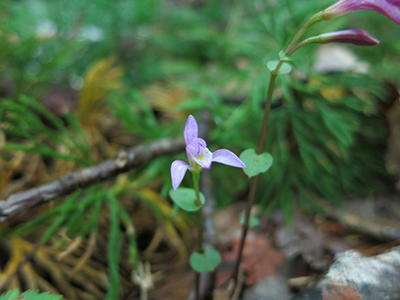Nodding Pogonia

Photo: Evan Raskin
Species information
This chapter provides a review of progress towards the protection and recovery of Nodding Pogonia in Ontario from 2007 to 2017.
Nodding Pogonia (Triphora trianthophoros) is a small inconspicuous orchid that has a highly specialized reproductive biology. It exists primarily underground and is dependent on a symbiotic mychorrhizal fungus that grows in the outer layer of the orchid’s roots. The fungus supplies nutrients to the plant that are stored in its fleshy roots and corms (rounded fleshy underground stems). In years when conditions are favourable, one to three flowering stalks emerge from the soil. The stalks are purplish-green, with one to several round leaves clasping the upper half. As many as seven, but usually three, flowers appear at the end of each stalk. The flower of the Nodding Pogonia is two-layered: an inner corolla composed of two white or pinkish top petals and a lower lip with green crests; and an outer layer of three white, petal-like sepals. Individual flowers develop to a specific stage and remain at that stage until particular temperatures occur. When conditions are right, each flowers opens, usually for one day only, ready for pollination by insects. The fruit is an erect green capsule. The seeds are wind-dispersed and depend on contact with the correct associated fungus for germination.
Nodding Pogonia occurs throughout eastern North America from New England to Texas, and south through Mexico, Guatemala, and Panama. In Canada, the species is restricted to two locations in southwestern Ontario: Rondeau Provincial Park and a woodlot in Essex County. It grows in rich, moist deciduous beech-maple woodland habitats, where there is deep leaf litter, an abundance of humus, and a substantial tree canopy that prevents drying out of the soils below. American Beech (Fagas americana) is a significant component of the forest canopy at these locations.
The primary threat to the protection and recovery of this species is the disruption of, or damage to, its association with the symbiotic fungus. Invasive plant species such as Japanese Barberry (Berberis thunbergii) and Garlic Mustard (Alliaria petiolata) secrete toxins into the soil that are highly damaging to soil microorganisms and can inhibit the growth of nearby plants and mychorrhizal fungi. Earthworm activity has been linked to extensive damage to forest ecosystems, including changes to the composition of materials on the forest floor, exposed soils and reduced fungal diversity. Herbivory by deer and other grazing animals has been reduced at both sites.
The survival and recovery of Nodding Pogonia are influenced by other factors as well. The highly specialized nature of the species’ biology reduces the chances of reproductive success. The two small, isolated populations in Ontario are vulnerable to extirpation by stochastic events such as a damaging wind storm, severe drought or flooding. Also, the resulting loss of genetic diversity decreases the species’ ability to adapt to landscape-level events such as climate change.
Nodding Pogonia is listed as endangered at both the provincial level (Species at Risk in Ontario (SARO) List) and federal level (Schedule 1 under the Species at Risk Act). Globally, it is considered to be vulnerable (NatureServe Explorer).
Provincial status
Prior to the Endangered Species Act, 2007 (ESA or “the Act”), the Committee on the Status of Species at Risk in Ontario (COSSARO) assessed Nodding Pogonia as endangered, and it was regulated under the previous Endangered Species Act in 2003. COSSARO reassessed Nodding Pogonia in 2011 and reconfirmed its status as endangered. Nodding Pogonia continues to be listed as endangered under the ESA. In future assessments, COSSARO may consider information gained through protection and recovery actions regarding the species’ threats and trends in population and distribution.
Species and habitat protection
Protecting Nodding Pogonia and its habitat are key components in the implementation of the ESA and continue to be government-led actions, as identified in the government response statement (GRS). As a species that was regulated under the previous Endangered Species Act, Nodding Pogonia has received species and habitat protection since 2003 and retained these protections under the ESA. The Act prohibits the species from being killed, harmed, harassed, captured or taken and its habitat from being damaged or destroyed. Habitat protection for this species is based on the general habitat definition in the Act. The ESA does not require a habitat regulation to be developed for transition
Any person who negatively impacts Nodding Pogonia or its habitat without prior authorization may be prosecuted under the ESA.
Nodding Pogonia has been protected from being killed, harmed, harassed, captured or taken since 2003.
In addition, the habitat of Nodding Pogonia has been protected from being damaged or destroyed since 2003.
Recovery strategy
A recovery strategy for Nodding Pogonia was published on January 11, 2013, which was in advance of the date required by the ESA. Recovery strategies are advice to government and represent the best available scientific knowledge. The strategy identifies the habitat needs of the species and the threats that it faces, while recommending objectives and approaches for its protection and recovery. The recovery strategy also includes recommendations on the areas of habitat to be considered in the development of a habitat regulation.
Government response statement
The government published the GRS for Nodding Pogonia on October 11, 2013, which was within the timeframe required by the ESA. The GRS is the Government of Ontario’s species-specific policy on what is needed to protect and recover the species, and includes an associated recovery goal.
Recovery Goal
The government’s goal for the recovery of Nodding Pogonia is to maintain or improve the viability of existing populations in Ontario.
To help achieve this goal, the government leads, supports, and prioritizes recovery actions identified in the GRS. Common actions for the government to lead as it works towards achieving a species’ recovery goal are provided in section 2.5 of the Species at Risk Program Status (2008-2015). In addition to the common actions, a government-led action that is specific to Nodding Pogonia is:
- Continue deer population monitoring and management at Rondeau Provincial Park to minimize the threat of overgrazing on Nodding Pogonia.
The GRS for Nodding Pogonia also lists five actions the government supports others to undertake for the species. These government-supported actions fall under the objectives identified in the GRS, which are:
- Protect existing Nodding Pogonia populations and reduce or remove threats
- Expand knowledge of Nodding Pogonia population size, condition, and threats
Ontario’s Invasive Species Act
The GRS for Nodding Pogonia indicates that invasive species (e.g. Garlic Mustard) pose a threat to the survival and recovery of the species in Ontario. The Ontario Invasive Species Strategic Plan, 2012 and the Invasive Species Act, 2015 provide the policy and legislative framework to support the prevention, detection and control of invasive species in Ontario. This framework may support actions to reduce the threats of invasive species.
Government-funded projects
An important government-led action in the GRS for Nodding Pogonia is to support partners to undertake activities to protect and recover the species. Through the Species at Risk Stewardship Program, the government has supported five projects ($378,405) designed to contribute to the protection and recovery of Nodding Pogonia. All of these projects targeted multiple species at risk, including Nodding Pogonia. Partners reported that they were successful in securing additional funding ($596,845) from other sources. This amount includes in-kind support in the form of time and expertise provided by volunteers.
Stewardship partners reported that provincial funding helped them to secure in-kind support by involving 187 individuals who volunteered 7,908 hours of their time towards protection and recovery activities for multiple species at risk, including Nodding Pogonia, which has an estimated value of $194,895. In addition, the partners reported providing outreach on multiple species at risk, including Nodding Pogonia, to 5,720 individuals.
The government also supports proponents in conducting research that addresses important knowledge gaps for species at risk. Through the Species at Risk Research Fund for Ontario, the government provided funding to a research partner to collect and analyze pollen samples to facilitate identification and location of cryptic plant species at risk, such as Nodding Pogonia. It has a very distinctive genetic code and can be readily distinguished from other orchid species.
The remainder of this section highlights a project supported through the Species at Risk Stewardship Program as well as the corresponding government-supported recovery actions for Nodding Pogonia.
In 2014, Dr. Jenny McCune of the University of Guelph and her team of researchers used computer models to predict suitable habitat for eight species of rare woodland plants. The models can help to identify the best places to search for previously unknown populations of the species. Under testing, the models effectively predicted the distributions of seven of the eight species examined, which led to the discovery of new populations of four of the eight species (McCune 2016). Building on this research, in 2017 models for additional woodland species at risk, including Nodding Pogonia, were developed. Eight predictive maps of suitable habitat for Nodding Pogonia in southern Ontario based on known locations and using different combinations of 14 environmental variables, including climatic, topographic, geological, and land cover data.
Because there are so few records of Nodding Pogonia, it is possible that all of the models are too conservative, and that there is suitable habitat beyond the predictions of the model. In both models, the most important habitat predictors included surficial geology, soil texture, and annual mean temperature. Sites predicted to be suitable for Nodding Pogonia tend to occur on coarse- or fine-textured glaciolacustrine geological deposits. According to the model, suitable habitat tends to occur on sandy loam or sandy soils, and not on clay soils. However, this may be because clay soils are dominated by crop-based agriculture. Sites predicted to be suitable are limited to locations where the annual mean temperature is higher than 8.5 degrees Celsius. The most conservative model also indicated that land cover was an important determinant of habitat suitability, showing that Nodding Pogonia tends to occur in forested areas (not surprising for a woodland plant).
In cooperation with private landowners, field surveys were conducted at 70 sites predicted to have suitable habitat for at least one of the modelled species. However, due to time constraints, no sites predicted to be suitable for Nodding Pogonia were surveyed, and no new locations of the species were discovered. To raise awareness of the Nodding Pogonia, a factsheet was developed that includes photos of the species, a map of the area of Ontario predicted to provide the most suitable habitat, a description of the habitat, and tips on how to distinguish Nodding Pogonia from similar looking species.
This project supports the GRS action to develop and implement a standardized monitoring protocol for all existing populations to gather information including population numbers and health, habitat characteristics such as vegetation type, and the presence of threats.
Species at Risk Stewardship Fund
-
 5
5projects included Nodding Pogonia
-
 $378,405
$378,405for multi-species projects that included Nodding Pogonia
-
 $596,845
$596,845in additional funding and in-kind support
-
 187
187volunteers
-
 7,908
7,908volunteer hours
-
 5,720
5,720people received outreach
Efforts to minimize adverse effects on Nodding Pogonia
Supporting partners through permits and their associated conditions is an important government-led action. To date, no permits have been issued for Nodding Pogonia.
One activity that may affect Nodding Pogonia or its habitat has been registered under ‘Possession for educational purposes, etc.’ (section 23.15) of Ontario Regulation 242/08 under the ESA. The registration requires the registered individual to comply with all conditions of the regulation, such as:
- In the case of a living member of a species, the educational organization must take reasonable steps to ensure that the member is safe from harm while in its possession;
- The educational organization in possession of the living or dead member of a species or parts of the species must create a detailed record that includes all of the information required under the regulation; and
- The records must be maintained and copies made available to the government upon request.
-
1registration
Occurrences of Nodding Pogonia in Ontario
Two populations
The government’s central repository at the Natural Heritage Information Centre (NHIC) has received 69 records of the species, from a variety of sources, based on observations made between 1950 and 2008. Forty-one of these records have been received since 2008, however, there have been no new observations since 2008. The observations received have helped to refine where the species is known and has been known to occur, and have provided additional information on the species’ habitat and threats.
In 2008, 34 person hours of search time was spent checking both sites for Nodding Pogonia. Regarding the Rondeau population, the habitat was described as very good and more than 1,900 stems of the plant were counted. Accordingly, this population has a ranking of excellent estimated viability. The Hillman population was last observed in 1985; in 2008, no plants were observed, and the population was identified as historical.
It is possible that there are observations of Nodding Pogonia that have not been submitted to the government. Encouraging the submission of observations of this species to the government is included in the GRS as a government-led action. Submission of species observations increases our knowledge of where they occur and can play an important role in assessing the viability of species populations.
Everyone is encouraged, or may be required by an authorization or approval, to submit observations of Nodding Pogonia, and any other species at risk observed, to the government’s NHIC for incorporation into the provincial record of observations.
69 observations of this species were submitted to the NHIC since 2008
Summary of progress towards meeting the recovery goal
Summary of progress
Progress has been made towards all of the government-led actions and government-supported actions outlined in the GRS for Nodding Pogonia. The Government of Ontario has directly undertaken actions to:
- Continue deer population monitoring and management at Rondeau Provincial Park to minimize the threat of overgrazing on Nodding Pogonia
- Educate other agencies and authorities involved in planning and environmental assessment processes on the protection requirements under the ESA
- Encourage the submission of Nodding Pogonia data to the government’s central repository at the NHIC
- Undertake communications and outreach to increase public awareness of species at risk in Ontario
- Protect Nodding Pogonia and its habitat through the ESA
- Support conservation, agency, municipal and industry partners, and Indigenous communities and organizations to undertake activities to protect and recover Nodding Pogonia. Support will be provided through funding, agreements, permits (including conditions) and/or advisory services
- Establish and communicate annual priority actions for government support in order to encourage collaboration and reduce duplication of efforts
Government-supported actions are organized under recovery objective focus areas. Progress has been made towards all of the government-supported recovery objectives and all of the associated actions identified in the GRS for Nodding Pogonia.
Under the objective to protect existing Nodding Pogonia populations and reduce or remove threats, progress has been made towards the single action to:
- Collaborate with landowners to implement best management practices (BMPs) that promote the recovery of Nodding Pogonia. BMPs may include woodlot management to improve habitat, invasive species removal or mitigation of other threats (Action No. 1 – High Priority).
This action has been implemented through two multi-faceted outreach and education programs supported by the Species at Risk Stewardship Program. The projects included components such as organizing community stewardship workshops, assessing habitats to develop landowner conservation action plans, and distributing information products about individual species including Nodding Pogonia.
Under the objective to expand knowledge of Nodding Pogonia population size, condition, and threats, progress has been made on two of the four actions:
- Develop and implement a standardized monitoring protocol for all existing populations. The protocol may include gathering information on: population numbers and health; reproductive success; habitat characteristics such as vegetation type; and the presence of threats (Action No. 2); and
- Implement standardized surveys of suitable habitat to look for new populations, including known historic locations. Surveys should be conducted over several years to increase the likelihood of detection (Action No. 3).
These actions have been implemented through projects supported by the Species at Risk Stewardship Program to determine life history traits and risk factors in Orchidaceae species, including Nodding Pogonia. Another project involved developing distribution models to enhance monitoring for forest plant species at risk by predicting locations with the highest probability of species presence.
Initial progress has been made towards the other two actions under this same objective:
- Evaluate the impact and severity of threats to Nodding Pogonia which may include: invasive plants impacting the critical fungi associated with the roots of Nodding Pogonia; earthworms altering the soil characteristics; habitat degradation from loss of forest cover due to clearing or Beech bark disease; and grazing by deer or other animals (Action No. 4); and
- Research the conditions necessary for successful reproduction to occur, including length of dormancy, flowering, pollination, and dispersal distances to inform an adaptive management approach to recovery. Collaborate with other jurisdictions to share knowledge as appropriate (Action No. 5).
These actions have been implemented by projects supported by the Ontario Stewardship Program. One project involved a study to determine the degree of risk that identified threats pose to various orchid species including Nodding Pogonia. A research project to undertake a genetic analysis of pollen samples from eight forest plant species at risk was conducted to determine markers for rapid identification of individual species.
The recovery goal for Nodding Pogonia is to maintain or improve the viability of existing populations in Ontario. Effort made towards the government-led and government-supported actions has helped to make progress towards the recovery goal for Nodding Pogonia. One of the two known sites for the species has been determined to have excellent viability, and habitat suitability modelling has identified additional locations with suitable habitat conditions for the species. This work will help focus future survey efforts.
Recommendations
As stated in the GRS, this review of progress can be used to help identify whether adjustments are needed to achieve the protection and recovery of the species. Based on progress to date, the overall direction provided in the GRS for Nodding Pogonia should continue to guide protection and recovery of the species. Relative to actions that have received a higher level of support, the following action has received less support and may be considered in future decisions regarding the protection and recovery of the species:
- Evaluate the impact and severity of threats to Nodding Pogonia (Action No. 4).
Although initial progress has been made, further work is required to fully implement standardized surveys of suitable habitat to look for new populations, including known historic locations (Action No.3).
Moving forward, protecting and recovering Nodding Pogonia will continue to be a shared responsibility that will require the involvement of many individuals, organizations and communities. Financial support for the implementation of actions may be available through the Species at Risk Stewardship Program. The government can also advise if any authorizations under the ESA or other legislation may be required to undertake a project. By working together, progress can continue to be made towards protecting and recovering Nodding Pogonia in Ontario.
Summary of progress towards the protection and recovery of Nodding Pogonia (2007 to 2017)
Provincial status
Nodding Pogonia is classified as endangered under the Endangered Species Act, 2007 (ESA). Nodding Pogonia was also listed under the previous Endangered Species Act, and has retained the same status since transition to the ESA. Nodding Pogonia has received species and habitat protection since 2003.
Species-specific documents and guidance published by the government
- Recovery strategy for Nodding Pogonia (2013)
- Nodding Pogonia: Ontario Government Response Statement (2013)
Government-supported stewardship projects
- Through the Species at Risk Stewardship Program, the Government of Ontario has enabled its stewardship partners to conduct five projects ($378,405 that have supported the protection and recovery of multiple species at risk, including Nodding Pogonia.
- The government’s support helped its stewardship partners to involve 187 individuals who volunteered 7,908 hours of their time towards protection and recovery activities for species at risk, including Nodding Pogonia. The estimated value of these voluntary contributions, as well as additional funding and in-kind support, is $194,895.
- Stewardship partners reported providing outreach on multiple species at risk, including Nodding Pogonia, to 5,720 individuals.
- Through the Species at Risk Research Fund for Ontario, the government supported a research partner to collect and analyze pollen samples to facilitate identification and location of cryptic plant species at risk, such as Nodding Pogonia. Another research project involved the use of habitat suitability modelling to identify additional locations with suitable habitat conditions for the species. This work will help focus future survey efforts.
Supporting human activities while ensuring appropriate support for species recovery
- One activity has been registered for the species. The activity was registered under ‘Possession for educational purposes, etc.’ (section 23.15) under Ontario Regulation 242/08 of the ESA.
Occurrences and distribution
- Two populations of Nodding Pogonia have been documented along the Lake Erie shoreline in southwestern Ontario. Currently, one population is extant, and the other is considered to be historical.
- In 2008, more than 1,900 stems of Nodding Pogonia were observed at the site of the population in Rondeau Provincial Park, and the habitat was described as very good. Accordingly, this population has a ranking of excellent estimated viability.
Related information
Categorizing and Protecting Habitat under the Endangered Species Act
Natural Heritage Information Centre
Ontario’s Endangered Species Act
Ontario’s Endangered Species Act Regulation 242/08
Ontario Recovery Strategy and Government Response Statement for Nodding Pogonia
Policy Guidance on Harm and Harass under the Endangered Species Act
Species at Risk in Ontario List
Species at Risk Stewardship Program
References
McCune, J. L. (2016). Species distribution models predict rare species occurrences despite significant effects of landscape context. Journal of Applied Ecology 53: 1871-1879.
Footnotes
- footnote[1] Back to paragraph A transition species, for the purposes of this report, is an endangered or threatened species listed under schedule 1, 3, or 4 of the ESA that has not changed in status since June 2008.
- footnote[2] Back to paragraph A population is defined as an area of land and/or water on/in which an element (e.g., Nodding Pogonia) is or was present. They are comprised of one or more observations and the area has a practical conservation value as it is important to the conservation of the species. An element occurrence is the technical term used to describe this.
- footnote[3] Back to paragraph A population is considered historical if it has not been recorded within the last 20 years. Historical populations may still exist, but updated information is not available.